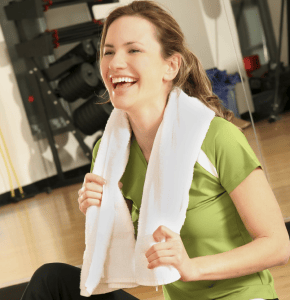“I was a marathon runner until my migraine became intractable and chronic daily. I lived to run. It was my physical and psychological outlet. Then…boom…it came to a screeching halt. I began walking, which soon became my lifeline. That is until 2 years ago when I developed vestibular migraine and had 3 serious falls while walking. Now I’m happy to walk with my cane under the guidance of my headache specialist and close friend, Liz, who has shown me the meaning of gentle movement and meditation.”—Kelly
Do You Have an Individual Exercise Plan? The Benefits of Exercise
 Healthy people need to understand how hard it is for those of us with migraine to move our bodies. As if paying the physical price isn’t enough, the psychological price of wondering if something like a short walk will trigger a migraine attack can be equally as debilitating. However, we know that regular exercise can help reduce the frequency of migraine attacks. Not only can exercise decrease stress, a common trigger, but it also helps with sleep and improved mood.
Healthy people need to understand how hard it is for those of us with migraine to move our bodies. As if paying the physical price isn’t enough, the psychological price of wondering if something like a short walk will trigger a migraine attack can be equally as debilitating. However, we know that regular exercise can help reduce the frequency of migraine attacks. Not only can exercise decrease stress, a common trigger, but it also helps with sleep and improved mood.
Exercise helps manage symptoms and triggers of migraine by:
- Releasing endorphins, the body’s natural painkiller
- Inducing a positive feeling and a sense of well-being which can be especially beneficial for those with migraine, as we face an increased risk of anxiety and depression
- Improving sleep hygiene
- Relieving stress
Getting Started on Your IEP
Getting started can be difficult, but research supports that the experience of some form of exercise, small or large, can help with symptom relief. The benefit of exercise as a prophylactic treatment (a course of action to prevent disease) for migraine to significantly decrease pain intensity, as well as the frequency and duration of attacks, has also been demonstrated.
The what, when and how of exercise varies with each person. This is where your Individual Exercise Plan (IEP) needs to be created. The best way of introducing more movement into your day does not necessarily mean joining a gym or running, but rather starting with something easy like stretching. Making a change in your daily activity is as simple as incorporating more movement. Gradual increase in movement is helpful as a treatment for migraine since it can potentially help get you out of the cycle of having migraine attacks brought on only by exercise. This will make you more likely to continue to stay active.
In researching what to do about keeping us moving with migraine disease, here is a small list of possible choices to start your IEP:
- Chair exercises can be a great way to start, and can help you build strength, stamina, core and balance. These are must-haves as we get older!
If you have dizziness and are looking to start easy and gentle you may also want to try:
- The Daily Om, which has a few options including Tai Chi, chair stretches, and chair yoga. The cost is low if you make a donation of your choice
- YouTube has a mother-daughter duo called “Yes2Next.” Here you can choose multiple videos to try
- Other free options are Warm up for Seniors/Beginners; Beginner Get Moving Workout in a chair and no jumping
- If you are able to walk without falling then gentle walking can be a great way to start, or even using an “under-the-desk” glider while you’re sitting on the couch or working
Final Tips
Depending on your symptoms and co-morbid (additional) conditions, it’s best to check with your health care provider before starting an exercise plan. This is also true if you are new to exercising, or haven’t exercised in a while. They will be able to help you figure out what might be most appropriate for you. Then as you start creating your IEP, bear in mind these final tips. These will help make sure you have a positive experience, and see exercise as a positive addition to your life:
- Make sure to be patient with yourself
- Remember to breathe during exercising
- Be gentle to your body
- Aim low at first and keep building upon your skills.
YOU CAN DO SOMETHING to help yourself physically and psychologically without increasing stress or pain. So, take it easy, try some basic stretching from a chair and keep us posted on how you are feeling.
Let Us Know!
Are you afraid to exercise because it might trigger or worsen your migraine attacks? What’s your favorite type of movement? Has it had a positive impact on your migraine, stress or overall wellbeing?
Sources:
https://thejournalofheadacheandpain.biomedcentral.com/articles/10.1186/s10194-018-0902-y
https://americanmigrainefoundation.org/resource-library/exercise-migraine